Huysmans, Groves & Michaux, and the Fortune Press
There is a lot of confusion about the dates of editions published by both Groves & Michaux and the Fortune Press, partly because of the obscure connections between the two firms and partly because many of the titles produced by the latter either included misleading dates in their prefaces and introductions, or didn’t include a date at all. The Fortune Press also tended to bind up only a small number of copies at any one time, which meant that the original printed sheets of an edition might appear in variant bindings produced decades apart, though all nominally belonged to the same edition. The most comprehensive list of publications by the Fortune Press is Timothy D’Arch Smith’s R. A. Caton and the Fortune Press (Bertram Rota, 1983; revised and expanded edition, Asphodel Editions, 2004. Additional information about Fortune Press editions, as well as other English translations of Huysmans’ work, can be found in Brian Banks’ The Image of Huysmans, AMS Press, 1990.) However, even D’Arch Smith’s dates can, in some instances, be improved on. It seems that he did not have access to the full run of the Bulletin de la Société Huysmans (1928 — present), which provides contemporary information about a number of Fortune Press editions that allow us to date their publications with more accuracy. This information seems fairly reliable given that it is often contemporaneous with the publication of the books themselves and that the translators of the later Fortune Press editions of Huysmans’ novels — Robert Baldick, Richard Griffiths and J. W. G. Sandiford-Pellé — were all members of the Society and probably supplied the Bulletin with information. Using this information, as well as that from a wide range of bibliographical sources, I have corrected publication dates where necessary, and noted the discrepancies with D’Arch Smith in the accompanying text. By including images of the cover, title page and last page of each edition, together with a list of distinguishing features and relevant bibliographical sources, I hope that some of the confusion over the dates of the various editions of Huysmans’ work that Groves & Michaux and the Fortune Press produced in the course of their erratic careers can be avoided. If anyone has any further information or corrections to the details listed here, I’d be grateful if they could contact me.
 |
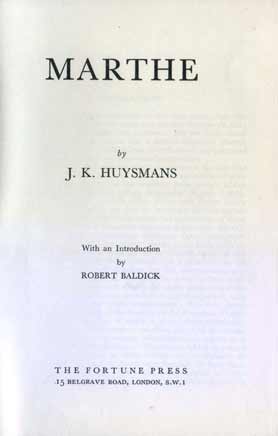 |

|
Marthe
London: Fortune Press, [1958].
Size: 5.25 x 7.75 inches
Pages: 82
Binding: Black
The first issue binding of this translation by Robert Baldick is much superior to later bindings. It was issued in a dustjacket that is now very difficult to find. The British Library catalogue gives the date of publication as 1958, as does the English Catalogue of Printed Books for 1960, covering the period 1956-1959, which gives an exact date of 27 August 1958, while the British National Bibliography gives a date of July 1958. However, the book is listed as appearing in 1957 in the Bulletin de la Société Huysmans, No. 35, which was published in July 1958. As Baldick was a member of the society it is likely that he provided them with the information, but whether this means that the book was due to be published in 1957 but was delayed, or that the Bulletin is in error is difficult to say. The Union Catalog gives a date of 1957, but qualifies it with a question-mark.
 |
 |
Living Together (En Ménage)
London: Fortune Press, 1969 [1971].
Size: 5 x 7.75 inches
Pages: 206
Binding: Red, Green
The last of Huysmans’ books to be published by the Fortune Press was edited and translated by J. W. G. Sandiford-Pellé. This edition is unique among Fortune Press editions of Huysmans’ work in that it actually prints a publication date, however D’Arch Smith gives the date as "1969 (i.e. 1971)" though doesn’t explain what this means. Presumably the book was prepared and printed in 1969 just before Caton’s death but only actually published in 1971, during the two years when D’Arch Smith tried to keep the company going. In 1972 the Bulletin de la Société Huysmans, No. 59, describes the translation as ’recent’ so the later of the two dates is probably more accurate. A dustjacket, with minimal liner notes (it doesn't even mention the name of the translator, for exaample) does exist, but is very rare and the book is more often listed without one.
 |

|
Parisian Sketches
London: Fortune Press, [1962].
Size: 5 x 7.75 inches
Pages: 88
Binding: Red
Translated by Richard Griffiths, with an introduction and notes. A dustjacket was produced, but it is now difficult to find and the book is more commonly seen without one. The publication date, although not given in the book itself is confirmed by a notice in the Bulletin de la Société Huysmans, No. 44 of 1962 and a review by Henry Lefai in the subsequent Bulletin for 1963, No. 45.
 |
 |
 |
Downstream
London: Fortune Press, [1952].
Size: 5.5 x 8.5 inches
Pages: 48
Binding: Red
Translated by Robert Baldick, this translation includes a short afterword which is dated 1952. Although the date of publication is given as 1956 in the British Library catalogue and by D’Arch Smith, the book is listed in the Bulletin de la Société J.-K. Huysmans No. 25, covering the first half of 1953, which gives full bibliographic details including a publication date of 1952. The edition is also dated 1952 in the bibliography of the Revue d’histoire littéraire de France for 1953. The book is distinguished by a striking etching as a frontispiece, which is unique in Fortune Press editions of Huysmans’ work and also by the fact that the publisher’s address is given as Jermyn Street, even though books issued before and after list the 15 Belgrave Road address.
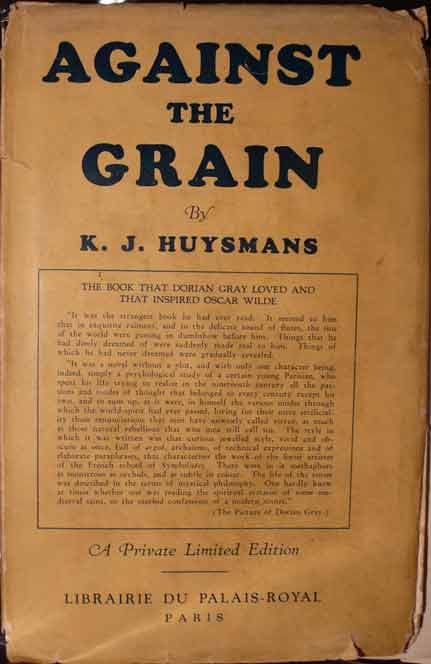 |
 |
 |
Paris: Groves & Michaux, 1926.
Size: 5.25 x 8 inches
Pages: 299
Binding: Blue
For details of the Groves & Michaux edition of Against the Grain, and its connection to the Fortune Press, see the section on the Fortune Press below.
 |
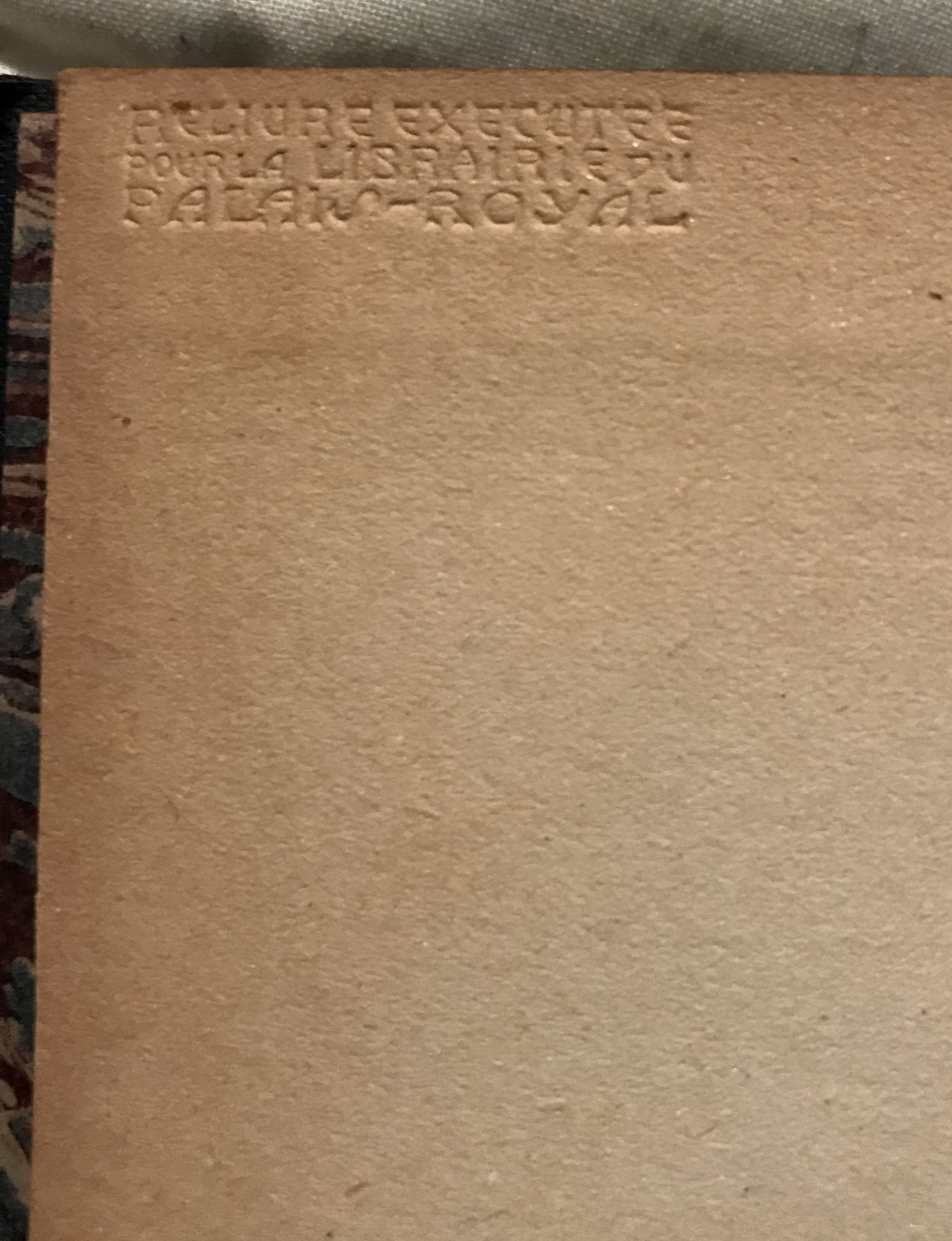 |
Against the Grain (variant edition)
Paris: Groves & Michaux, 1926.
Size: 5.75 x 8.375 inches
Pages: 299
Binding: Blue
Alongside the standard Groves & Michaux edition of Against the Grain (see above) there appears to be a small number of copies in an alternate binding. This version possibly constitutes an intended 'deluxe' edition, as it has a number of 'delux' features — marbled endpapers, a ribbon page marker, top edge coloured in red, and so on — or it may be that these copies were those produced by Groves & Michaux for internal use as reference or office copies. The distinguishing marks of this variant edition, aside from its larger size of 5.75 x 8.375 inches, are: a different binding which has 'Karl Joris Huysmans' and the book's title on the spine (as opposed to 'K. J. Huysmans', the book's title and 'Paris' on the standard edition); the front panel does not have the author's name and the book title stamped into it (as the standard edition has); elaborately marbled endpapers embossed with the Librairie Palais Royal stamp; a blue ribbon page marker; top edge coloured in red; and, lastly, the spine of the paperback printing bound into the back of the book (something that was a common practice with French bookbinders when putting hard covers on a paperback). This seems to indicate that the book was originally planned as a paperback, and then for some reason, perhaps because the paper cover included is rather thin, rebound as a hardback. Whether a dustjacket was planned for these books, or whether they used the same dustjacket as the standard edition isn't clear (though the difference in size in the two books would argue against this). At least three copies with identical binding, marbled endpapers, and with the paperback spine bound in are known to exist, but whether these constituted part of a larger run that was commercially available bor were simply copies bound up by Groves & Michaux for their own use is also unclear. The latter supposition gains weight in that the bindings of these 'deluxe' copies are stamped with the imprint of Groves & Michaux own bindery, as the office copies of Down There also were.
 |
 |
 |
Against the Grain
London: Fortune Press, [1931].
Size: 6 x 8.625 inches
Pages: 299
Binding: Black
The Fortune Press first edition of this anonymous translation of A rebours was produced from the leftover sheets of a limited edition (number unstated) printed and published in France by Groves & Michaux in 1926 (see above). According to Peter Mendes, in Clandestine Erotic Fiction in English 1800-1930 (Aldershot: Scolar Press, 1993), Michaux decided that he wanted to legally dissolve his business partnership with Frank Groves in 1930, and as a result a stocklist was prepared for potential buyers. R. A. Caton, who most probably knew of the firm’s activities beforehand — it is known that the Fortune Press printed some of their editions in France, either to save money or to avoid prosecution for obscenity in England — capitalised on the imminent break-up of Groves & Michaux to acquire some new stock. According to D’Arch Smith a list of Groves & Michaux’s stock was prepared for Caton in December 1930, and in March of the following year he bought shares in, and became a director of, the publishing-house-come-bookshop that specialised in selling under-the-counter literary erotica. However, as there don't seem to be any Groves & Michaux titles published after 1930, it seems that the firm was effectively dissolved as a publishing entity and Caton simply republished the titles he wanted under the Fortune Press imprint.
As far as Against the Grain is concerned, the fact that the Groves & Michaux edition had been on sale in France since 1926 probably accounts for the small size of the Fortune Press edition, which is given as 250. Interestingly the new justification page and title page in the Fortune Press edition are printed on the same paper as the original — which is also the case for their edition of Down There — so it seems likely that the new pages for both books were printed by the original French printer. The English Catalogue of Printed Books for 1936 — covering the period between 1931 and 1935 — lists the publication date of Against the Grain as June 1931. The copy held at the British Library confirms this with an accession date stamp of 20 August 1931. A short article in the Huysmans society Bulletin for December 1934 (No. 11) — under the heading ’Le livre qu’aimait Dorian Gray’, a French rendering of the wording on the cover of the Fortune Press edition of Against the Grain — announces the publication on 21 October 1933, ’en Angleterre, de deux traductions de romans de J.-K Huysmans’ — a fairly clear reference to the Fortune Press first editions of both Down There and Against the Grain. It is almost certain that this slightly misleading bibliographical information came from Montague Summers, as the same issue of the Bulletin also contains a note stating that an English member of the society has informed them that an edition of Down There has just been suppressed by the police. Summers’ reason for making this belated publication announcement was possibly an attempt to stir up support for the Fortune Press by stressing the publisher’s literary credentials. The list of books published by the Fortune Press on the back of the dustjacket of Against the Grain includes Down There, which was published — or at least produced — the year before in 1930.
 |
 |
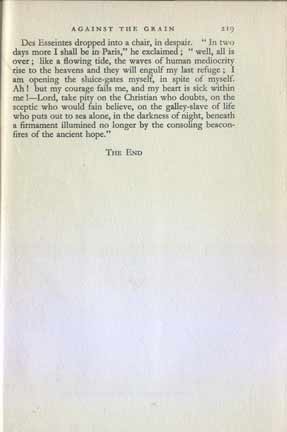 |
Against the Grain
London: Fortune Press, [c.1937].
Size: 5.25 x 7.75 inches
Pages: 219
Bindings: Red, Black, Orange
The second edition of this anonymous translation was produced in a limited edition — or perhaps editions — of 1000, sometimes numbered by a stamp and sometimes numbered by hand. The Buckingham Palace Road address on the title page confirms that it must have been produced prior to 1943, and the fact that there are copies in existence with accession dates from 1940 and 1941 indicate that the book was produced sometime in the 1930s. The list of other Fortune Press titles on the back of the dustjacket includes a number of titles published in 1936 as well as Bicycle Belle by Richard Blake Brown which probably appeared in 1937, so it is possible the book appeared slightly later than the date (c.1936) given in D’Arch Smith.
 |
 |
 |
À Rebours (Against the Grain)
London: Fortune Press, [c.1946].
Size: 5.25 x 7.75 inches
Pages: 200
Bindings: Orange
The third edition of this anonymous translation is distinguishable by a number of factors: it includes an introduction by P G Lloyd dated 1946, it has been completely reset and now has 200 pages instead of 219. The spine on the binding reads À Rebours, and the title page gives the title as À Rebours (Against the Grain). Unusually, the title page is printed in two colours, red and black, and the book is printed on the same thin war-time paper as the second edition of Là-bas.
 |
 |
 |
À Rebours (Against the Grain)
London: Fortune Press, [c.1948].
Size: 5.25 x 7.75 inches
Pages: 180
Bindings: Red
The fourth edition of this anonymous translation is in many ways similar to that of the third, in that it has the same introduction by P G Lloyd and the same 1946 date. However it has been reset and now has 180 pages. Even though there are less pages the book is considerably fatter than the third edition, which was printed on thinner war-time paper. The title page is now printed only in black and the address reads 15 Belgrave Road, SW1. Although the dustjacket gives the English title, the spine on the binding reads À Rebours, and the title page gives the title as À Rebours (Against the Grain).The list of other Fortune Press titles on the back of the dustjacket includes a number of titles published in 1947 and 1948. This edition not listed in D’Arch Smith.
Down There
 |
 |
 |
Down There
Paris: Groves & Michaux, [1930].
Size: 6.25 x 8.75 inches
Pages: 387
Bindings: Paper, Three-quarter chagreen
 |
 |
 |
Down There
London: Fortune Press, [1930].
Size: 6.25 x 8.75 inches
Pages: 387
Bindings: Black buckram
The lack of contemporary bibliographical information concerning both the Groves & Michaux and the Fortune Press first editions of Down There makes trying to untangle the book’s confusing publication history quite difficult. The English Catalogue of Printed Books, for example, makes no reference to the Fortune Press edition of Down There in 1930, though it lists the publication date of Against the Grain which appeared a year later, and there seems to be no contemporary reference to the Groves & Michaux edition at all. Confusion over the two editions is compounded in that, like its edition of Against the Grain, the Fortune Press edition of Down There is comprised of the printed sheets of the Groves & Michaux edition, but with the addition of a new title page and justification page (on matching paper and using some of the same typefaces, so presumably printed at the same printer in France). Bibliographical evidence may be in short supply, but by looking at such facts as there are, and at the secondary evidence surrounding them, the only credible conclusion to be drawn is that the Groves & Michaux edition of Down There was never actually put on sale commercially. The only copies of it that now exist are almost certainly the publisher's reference copies, making it the rarest of all editions of Huysmans in English translation: there are probably no more than 25 bound copies in existence.
The theory that the Groves & Michaux edition was never put on sale answers the major question that the appearance of the slightly later Fortune Press edition raises: if the Groves & Michaux edition had already been put on sale and copies sold commercially, why did Caton state that the Fortune Press edition comprised 2,050 copies, in other words the whole of the original print run? Although the existence of two legal deposit copies of the Groves & Michaux edition in the Biliothèque nationale, dated 5 June 1930, might imply that the publisher was still intending to sell the book, there are a couple of things that argue against this. Firstly, both legal deposit copies are not properly bound, being covered only by plain paper, this seems to suggest that the book wasn't ready for publication, and the fact that no subsequent copies have been found in a normal binding reinforces the view that the book wasn't produced commercially. Secondly, the Fortune Press edition was submitted to its respective legal deposit office, the British Library, only three weeks later, on 21 June 1930. It is possible, therefore, that Groves & Michaux had originally intended to produce a commerical edition and submitted maquette copies to the Bibliothèque nationale, but whether for lack of funds or some other dispute within the company, Groves & Michaux simply abandoned their edition shortly afterwards, and turned to the Fortune Press for financial assistance. It seems too that Groves & Michaux as a company may have ceased publishing altogether at this time — there are no titles listed in the Bibliothèque nationale, for example, after 1930, though the bookshop located at the same premises, Librairie de Palais-Royale, continued its activites as a point of sale and as a bindery. In any event, with the agreement between Groves & Michaux and the Fortune Press in place, Caton may simply have taken the opportunity to finish off the production of a book that had been printed but not yet put on sale.
Perhaps the most solid evidence for the Groves & Michaux edition never having been sold commercially is the sheer dearth of physical copies: I am aware of only one copy coming up for sale in secondhand bookshops or book sites, and there don't seem to be any traces of copies being sold at auction (I would be grateful if anyone does have a copy if they would contact me). Up to the present, in twenty years of collecting and searching, I have seen only six copies of the Groves & Michaux edition: the two accession copies in the Bibliothèque nationale and Bibliothèque de l'Arsenal, a publisher's reference copy bought by a bouquiniste in Paris a few years ago (it was bound in the same temporary paper cover as the legal deposit copies, and included a note from Frank Groves about Descaves' introduction), an almost identical publisher's reference copy sold on a secondhand book site which had been bought at auction in London during the late 1970s or early 1980s and had lain in a stockroom ever since, and two luxury bound copies which surfaced recently in Paris. The existence of these latter two bound copies tends to confirm the theory that the book was not put on sale, as they were originally sold as part of a lot that included a large number of books that came from Groves & Michaux's own private stock. These two copies are most likely either the publisher's own copies or part of a small number of copies bound up for special clients, both being delux specimens, three-quarter bound in chagreen, with gilt edging and marbled endpapers, and both bearing a stamp stating that they were bound by Groves & Michaux's own binders. It is unlikely that such elaborate and costly bindings would have been used for the advertised commercial edition.
Curiously, as if there were not enough uncertainty already in Down There’s production history, copies of the Groves & Michaux edition were advertised for sale in the Bulletin de la Société Huysmans, in October 1932. A possible source for this information might have been Pierre Dufay, a member of the Society who had worked for Charles Carrington’s bookshop (the stock of which was bought by Groves & Michaux after Carrington’s death). Dufay would have known Michaux, who had also worked for Carrington in the 1920s. Whether the book’s listing was simply a late notification of the proposed Groves & Michaux edition or a mistaken reference to the Fortune Press edition, which was most likely on sale through the Groves & Michaux bookshop, Librairie du Palais Royal, is unclear.
As for the Fortune Press edition, that too is extremely rare, though copies do regularly appear on secondhand book sites. A clue to how many Fortune Press copies exist or were produced lies in the fact that all the copies were numbered — and none of the copies that are held in libraries or that have come up for sale over the last few years have had numbers greater than 500. There is possibility therefore that Caton purchased only 500 sets of sheets, rather than the 2,050 that is the stated print run. The number of copies actually in existence is clearly far smaller than a print run of 2,050 would imply, though it is difficult to say exactly how small. By comparison, copies of the first Fortune Press edition of Against the Grain are very much easier to find, even though that was produced in an edition of only 250 copies. There are, however, clear and obvious reasons for the paucity of copies of Down There: it would not have made commercial sense for Caton to bind the whole edition in one go, for example. The Fortune Press edition of Down There is a relatively sumptuous affair, bound in black buckram with a gilt fore edge, so it is most likely that, as he did with later and less expensive Fortune Press editions, Caton bound up batches of copies as and when he needed them. Another more serious factor affecting the number of surviving copies is that of legal confiscation, either by customs or in targeted raids. The Bulletin de la Société Huysmans for December 1934 (No. 11) contains a short notice about a letter received “from an English member of the society” — i.e. Montague Summers — informing them that an edition of Down There had been suppressed by the police. Although Down There was indeed one of the books confiscated by the police raid on the Fortune Press in September 1934 — on suspicion of producing obscene literature — it seems as if the prosecution was at least originally aimed at other publications. However, the Fortune Press didn't get the confiscated copies back and this must have severely reduced the number of copies in circulation.
The translator of Down There is not named in either the Groves & Michaux edition — where the title page states only that it is “Translated by an Oxford MA” — or the Fortune Press edition, which doesn‘t mention a translator at all. However, it is fairly certain that the translator was Alfred Allinson. (See a magnificent essay by Rod Boroughs, ‘Oscar Wilde’s Translation of Petronius: The Story of a Literary Hoax’ in English Literature in Transition, Vol 38 January 1995.) Both the Groves & Michaux and Fortune Press editions contain a preface written by Huysmans’ literary executor, Lucien Descaves, which was translated into English by Frank Groves. Descaves submitted his preface as a dactylograph copy, rather than handwritten, saying that otherwise the publishers would have sold it as an autographed manuscript to collectors. The preface didn’t appear in any of the subsequent editions.
Although Montague Summers contributed to the bibliography and notes included in the subsequent bowdlerised versions of Là-bas which the Fortune Press put out in 1946 and 1952, he is not mentioned as having had anything to do with the first edition of Down There. It is possible, however, that he acted as some kind of advisor during its production. In an article Summers wrote about Huysmans and Dickens in 1946, he refers to Huysmans as ’Jorris Karl’ — the erroneous spelling of Huysmans’ name that appears on the covers of both Down There and Against the Grain. In this, Summers was reproducing Huysmans’ own error in the publication of his first book, Drageoir à épices, in which he mistakenly spelled the Germanic form of his first name with two Rs, though he corrected the spelling for all subsequent editions of his work.
 |
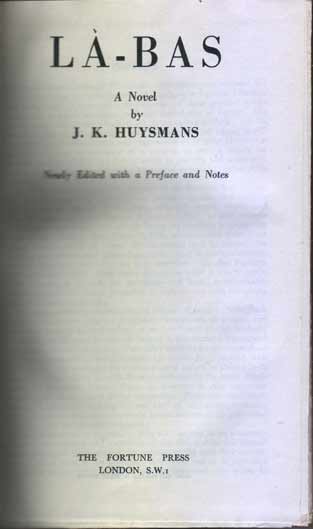 |
 |
Là-bas
London: Fortune Press, [1946].
Size: 6 x 9 inches
Pages: 216
Bindings: Black, Brown, Red, Orange
The second edition of Alfred Allinson’s translation was produced immediately after the war. Notable for the reversion to the French title, it has also been expurgated, probably to avoid a recurrence of the prosecution for obscenity of 1934. It is usually printed on thin, poor quality paper and in a larger format than the other later editions of Huysmans’ work. The book includes an unsigned preface, dated 1943, and notes by Alan Hull Walton, and a bibliography compiled by ’a member of the Société Huysmans’ i.e. Montague Summers. Although Montague Summers claimed to have been ’the only English member’ of the society — a claim that is often repeated by those writing about him — a simple check with the list of members periodically published by the Huysmans society itself shows that he was neither the only English member, nor was he a member of the society for very long — at most four years. His name is recorded among the list of members in Bulletin No. 11 (December 1934), but not in that of No. 7 (October 1932), nor that of No. 14 (May 1936), or indeed in any subsequent list, so he was no longer a member of the society at the time of the book’s publication. Interestingly the most recent book listed in either the bibliography or the notes is 1938, so it is conceivable that the book was underway before the war, but its publication delayed because of it. The address on the title page gives just SW1, so it is also possible that it was produced during a period of transition between addresses. The fourth edition of Against the Grain, which most likely dates from 1948 has the 21 Belgrave Road address, so it is probable the book was printed after 1943 when the Fortune Press left Buckingham Palace Road and before 1946, when it moved (more or less) permanently to Belgrave Road. Some copies, presumably from a later impression, have a title page that includes the 21 Belgrave Road address.
 |
 |
 |
Là-bas
London: Fortune Press, [1952].
Size: 5.5 x 7.75 inches
Pages: 230
Bindings: Grey, Black, Dark Blue, Red, Orange
The third edition of Alfred Allinson’s translation is a smaller, reset version of the second edition, which now has 230 pages instead of 216. The date of 1943 is omitted from the preface and the bibliography at the back now lists Downstream, which was published in 1952, a notice of which also appears on the back dustjacket.